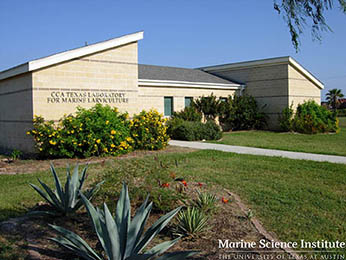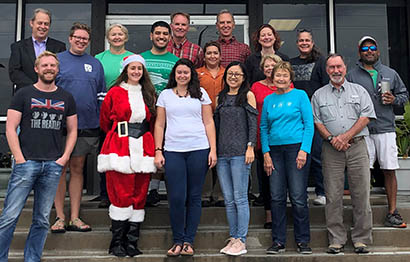CCA Texas Laboratory for Marine Larviculture

The CCA Texas Laboratory for Marine Larviculture is a specially designed facility for research on rearing larval fishes, one of the most significant bottlenecks in marine fish culture. Highly replicated experiments are the key to strong research and this 3,000 square foot building contains two seawater labs, each with three tanks that each hold 1,500 gallons. Each of these tanks can be divided into as many as 6 replicate tanks, making it possible to run experiments in 36 tanks at once. An important feature of the building is the extremely fine control of water temperature and salinity that can be maintained during experiments that last weeks or even months, making research possible year round regardless of the extremes of the outside conditions. The two labs are connected by a live food preparation area where algae, rotifers, and brine shrimp are cultured continuously to feed the delicate and finicky larval stages of a variety of species of fishes. Another connector provides office and laboratory space for researchers.
In January 2006, the University of Texas Marine Science Institute proudly announced a generous gift of funds from the Coastal Conservation Association - Texas to create a state-of-the-art facility for research into the early life stages of marine fishes. The staff of the Fisheries and Mariculture Laboratory immediately got to work on the design of their ideal laboratory, and the grand opening took place in August 2007. Since that time, the CCA Texas Laboratory for Marine Larviculture has been the site of several significant research efforts.
We are devoting a lot of research activity to southern flounder. We have defined the optimal temperature for rearing larvae from Texas. We also discovered how rearing temperatures alter the proportion of males to females. Results from both of these studies were markedly different from findings of colleagues working on southern flounder from North Carolina, highlighting the importance of geographic differences in this species. We have conducted trials to accelerate weaning -- switching from live food to a dry diet -- in southern flounder. We are examining the influence of yolk composition and larval diets on the ability of larval southern flounder to escape from predators after stocking, and how the larval diet might solve the problem of malpigmentation that develops in juvenile flounder, which makes them more susceptible to predators and less appealing to customers in the fish market.
We are also using this lab for work with several other species. We are developing rearing technologies for pigfish (Orthopristis chrysoptera) with the aim of successful commercial production of this popular baitfish. We investigated the feasibility of rearing all early life stages of red drum, from hatching through the early juvenile stage, entirely in recirculating systems using different stocking densities and weaning strategies. We studied digestive enzymes in juvenile cobia (also known as ling) and found that these fish are able to digest the chitin that makes up the shell of shrimp, suggesting that shrimp processing waste from could replace fish meal in cobia feeds to make the process more sustainable. We have also initiated studies of optimal lighting for larval survival and growth in red drum.
More about our research:
Facilities
The Fisheries and Mariculture Laboratory (FAML) has a large and diverse array of facilities and equipment to support our research in mariculture, physiology, ecology, and fisheries. FAML is situated on 10 acres of land adjacent to the channel that connects the Gulf of Mexico with Redfish Bay and Corpus Christi Bay. The channel provides a reliable supply of high quality seawater for use throughout our facility.
FAML's fish-keeping facilities are almost entirely recirculating systems that minimize the need to discharge effluent into the local environment. To achieve this, all of our large tanks have separate biological filters to maintain water quality. Recirculating systems also protect our research from variations in salinity and occasional toxic red tides that can occur in local waters.
We maintain 17 broodstock tanks that range in size from 10 to 23 feet in diameter and 6 raceways that are 8 feet wide and either 20 or 45 feet long. We also have a large capacity of highly replicated larval rearing experiments. We have two larval rearing laboratories, each with a capacity of at least 18 tanks. Two environmental chambers located within one of the larval rearing laboratories provides space for laboratory experiments on fish larvae under controlled conditions without the need to move larvae far from where they are maintained. We also have limited facilities for grow-out juvenile fishes.
The CCA Texas Laboratory for Marine Larviculture is specially designed facility for research on larval rearing. This 3,000 square foot building contains two seawater labs, each with three tanks that hold 1,500 gallons that can be divided into as many as 36 replicate tanks. The labs are connected by a live food preparation area where algae, rotifers, and Artemia are cultured. Another connector provides office space for researchers.
FAML is well equipped for a variety of laboratory analyses, ranging from molecular physiology to respirometry, growth, and motion analysis. Biochemical and physiological analyses make use of onsite high performance liquid chromatograpy (HPLC), gas chromatography, microplate spectrophotometry, a freeze dryer, and thermocyclers for quantitative real time polymerase chain reaction (PCR and qPCR. Microscopy capabilities include confocal and light microscopy, cryostat, and microtomes for histology.
People
Principal Researchers
Associated Researchers
Research Support Staff
Graduate Students
Support Staff
|
 FAML staff then |
Physiology
The fish physiology group at the Fisheries and Mariculture Laboratory (FAML) is rooted strongly in basic research questions pertaining to the environment, ecology, and evolution of marine fishes. Our excellent holding facilities provide us with a unique ability to obtain and house a wide array of species, including pelagic species that are traditionally regarded as hard to work with. Our long-established captive spawning and larval rearing program also provides us with access to a number of different life stages.
Environmental Physiology
The ocean is a surprisingly diverse ecosystem that can range widely in a number of basic characteristics including oxygen saturation, pH, salinity and temperature. Environmental physiology focuses on the physiological mechanisms that allow fishes to survive in this often dynamic environment. Some of the specific research questions in environmental physiology currently being pursued at FAML include:
OCEAN ACIDIFICATION
-
Anthropogenic carbon dioxide release is resulting in gradual acidification of the marine environment with far-reaching consequences. We aim to assess these impacts on recreational and commercially relevant species of the Gulf Coast, such as red drum (Sciaenops ocellatus) and southern flounder (Paralichthys lethostigma). We investigate the mechanistic impacts on homeostatic processes in these animals, as well as their capacity to adapt to this gradual environmental change.
SALINITY AND WATER BALANCE
-
Estuaries along the Coastal Bend of South Texas are critical nursery areas for larvae and juveniles of many fish species. Interestingly, salinity can vary dramatically between estuaries, from extreme hypersalinity to near fresh water. Even within a single estuary the impacts of periodic freshwater inflow can change a given environment from hypersaline to hyposaline; two fundamentally different physiological challenges. We are investigating the mechanisms by which red drum, for example, are able to maintain osmotic balance in this dynamic environment, especially with respect to the very sensitive early life stages.
Eco-physiology
This emerging branch of physiology operates at the interface of physiology and ecology, focusing on questions that directly impact behavior, population dynamics, and fitness. Some specific research questions in eco-physiology currently being pursued at FAML are:
NUTRITION AND LARVAL SUCCESS
-
Proper nutrition is crucial to fish survival and success. We have found, using a suite of behavioral assays, that essential fatty acid composition of eggs is correlated with escape performance of larvae. We are currently investigating the role that parental diet plays in larval success by elucidating the dynamics of transfer of specific fatty acids from maternal diet to eggs and the specific fatty acid(s) that cause subsequent changes in larval survival skills.
SENSORY ECOLOGY
-
A crucial component of the success of larvae of estuarine-dependent fishes is their ability to locate suitable nursery habitat. For larvae of several local species, this is often the area in and around seagrass beds. We are currently investigating the environmental cues that red drum larvae use to locate seagrass beds, including auditory, olfactory, and visual cues. This work involves a combination of laboratory assays that measure directional and non-directional response combined with field experiments to examine behavior under natural circumstances.
EXERCISE AND PHENOTYPIC FLEXIBILITY
-
Fishes show a wide range in their capacity for exercise, from benthic sedentary species, such as southern flounder, to free-swimming pelagic species, like mahi-mahi (Coryphaena hippurus). We are examining the physiological traits and trade-offs of these lifestyles and the ability of specific traits to change in response to exercise regimens.
Evolutionary Physiology
This branch of research takes advantage of the substantial number of evolutionary lineages found in the marine and freshwater environments to investigate physiological adaptation throughout vertebrate radiation.
Some specific research questions currently being pursued at FAML are:
EVOLUTION OF RESPIRATORY GAS TRANSPORT IN WATER BREATHERS
Carbon dioxide transport is a multifaceted process involving a number of different proteins. Interestingly, the levels and localization of these proteins vary among teleosts, and even more so when compared to ancestral water-breathing organisms such as sharks, lampreys, and hagfishes. We are examining the adaptive significance of this variation, with specific interest in the role of red blood cells.









